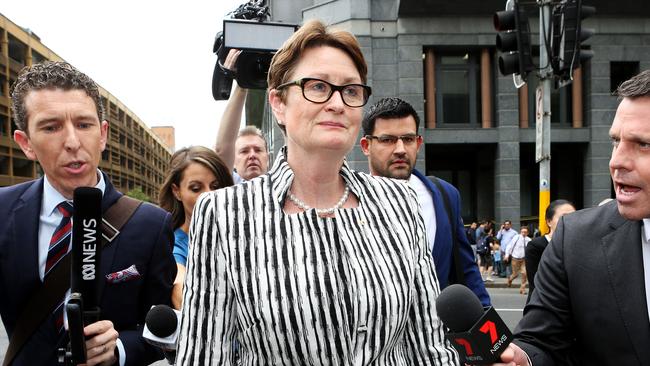D-Day on pay policies as CBA grilled
The intricacies of CBA’s deliberations over executive pay have been laid bare at the Hayne royal commission.

The intricacies of Commonwealth Bank’s deliberations over executive pay were laid bare yesterday as the Hayne royal commission dissected board disclosures, methodologies and consequences that followed the bank’s trail of explosive scandals.
CBA chairman Catherine Livingstone conceded on several occasions that the board should have probed more deeply into the long list of compliance issues and their characterisation by executives, and enforced bigger pay consequences.
“There was not enough challenge and that would be through inquiring and interrogating of particular matters,” she said.
Ms Livingstone said CBA was still assessing its broader remuneration structure, including gauging models suggested by the prudential regulator in the UK.
“We are struggling with this. We are currently looking at our remuneration framework as we evolve it still further,” Ms Livingstone said.
Appearing after Ms Livingstone, Westpac chief Brian Hartzer was quizzed about pay structures in car dealerships that offer finance and paid commissions to financial advisers. He is likely to face further questions on executive remuneration and accountability when he returns to the witness box today.
Counsel assisting the commission Rowena Orr QC undertook a forensic investigation of information tabled to the CBA board and queried whether its pay decisions sent a “strong message” to staff about what was acceptable.
Documents she tendered showed that in 2017, then CEO Ian Narev wrote to the board recommending that executives who had some responsibility for the anti-money laundering breaches have just 10 per cent of their bonus forfeited. He suggested wealth management boss Annabel Spring take a further 20 per cent cut due to that unit’s ongoing compliance issues.
The documents also showed the board largely agreed with Mr Narev’s recommendations, until Austrac started public legal proceedings forcing the board to convene a crisis meeting where it decided to cut short-term bonuses to zero for all executives.
Commissioner Kenneth Hayne also weighed into the pay and accountability debate, questioning how pay formulas worked and what they were able to measure.
“Does the degree of specificity and detail that is applied in truth serve to mask the lack of critical judgment about what really matters?” he asked.
CBA whistleblower Jeff Morris — who has been in attendance at the royal commission this week — told The Australian the revelations about the bank proved the federal government should have kicked off the process four years ago.
“Just the calling of the royal commission is the only thing that got these guys going,” he said.
On Mr Comyn’s statements about former CEO Mr Narev’s accountability this week, Mr Morris said: “What he was saying was the CEO was responsible for what happened back then, and you couldn’t disagree with that.”
Mr Morris also said he tried to raise two new cases of misconduct with Mr Narev in 2014 and the CEO “did nothing” with the information.
Aggrieved CBA customer Tony Di Donato had similar criticisms of Mr Comyn, saying he didn’t hold true to public statements of a ‘‘willingness to meet bank victims’’ until he confronted the CEO publicly at the bank’s annual general meeting in Brisbane. Following that a meeting a with Mr Comyn was set up for December.
“What they are saying in public, and under public scrutiny, does not match what is actually happening behind closed doors for bank victims and this is an ongoing behaviour that all victims have expressed in my case for seven years,” Mr Di Donato said.
CBA’s board minutes were also scrutinised by the royal commission and their legality questioned by Ms Orr, after she failed to find reference to a key question asked by Ms Livingstone at a 2016 meeting.
But Ms Livingstone said board minutes were not a verbatim account of the meetings.
“It’s not possible for the minutes to record every single question in a board meeting,” she said.
Mr Hartzer also faced intense scrutiny yesterday as documents tendered showed low audit pass rates were recently recorded for its in-house financial planners and those that sat under the bank’s licence.
The results showed that in-house planners had a pass rate of 61 per cent while the other group came in at 60 per cent, for the month ended September 21.
The document also said the control environment for certain risks was rated “unsatisfactory” during the 2018 financial year.
Mr Hartzer said Westpac wanted to continue to provide financial advice but the environment of increased compliance and conduct risk made it more challenging.
“My view is that, yes we can, and yes we should,” he said. “However, the economics of doing that are getting very difficult.”
Mr Hartzer also conceded that the poor state of Westpac’s record keeping meant assessing its potential customer remediation for charging fees when no services were provided was difficult and would take more time.
That was exacerbated by the systems issue making it difficult to identify which customers were impacted, and Mr Hartzer said in some areas it was being assessed on a “benefit of the doubt” basis.
The royal commission heard Westpac was still engaging with the corporate regulator over a review of Securitor and Magnitude.



To join the conversation, please log in. Don't have an account? Register
Join the conversation, you are commenting as Logout